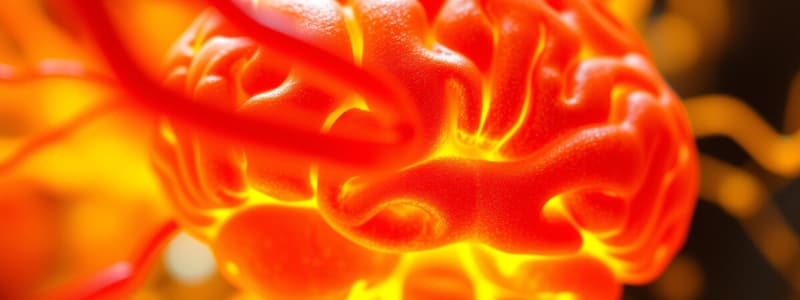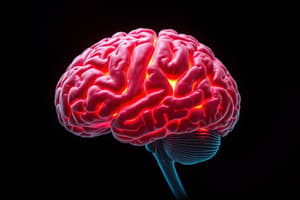Podcast
Questions and Answers
What is the primary responsibility of Betz pyramidal neurons in the primary motor cortex?
What is the primary responsibility of Betz pyramidal neurons in the primary motor cortex?
- Regulating sensory input to the spinal cord
- Facilitating insular cortex function
- Coordinating activities of all muscle groups
- Controlling skilled movements of the hands and fingers (correct)
Which of the following statements about upper motor neurons is accurate?
Which of the following statements about upper motor neurons is accurate?
- They only activate muscle groups in the arms.
- They primarily originate from the somatosensory cortex.
- They control movements rather than individual muscles. (correct)
- They control individual muscles directly.
What percentage of pyramidal tract neurons cross the midline (decussate)?
What percentage of pyramidal tract neurons cross the midline (decussate)?
- 90% (correct)
- 50%
- 10%
- 75%
What primarily determines the function of the corticobulbar tract?
What primarily determines the function of the corticobulbar tract?
Which cortical layer contains the upper motor neurons that control volunteer movements?
Which cortical layer contains the upper motor neurons that control volunteer movements?
What is the role of corticospinal tract axons in terms of muscle control?
What is the role of corticospinal tract axons in terms of muscle control?
Which statement best describes the participation of the somatosensory cortex in motor control?
Which statement best describes the participation of the somatosensory cortex in motor control?
What is a significant aspect of the encoding of movement parameters by upper motor neurons?
What is a significant aspect of the encoding of movement parameters by upper motor neurons?
Which tract is primarily responsible for connecting upper motor neurons from the cortex to lower motor neurons in cranial nerve nuclei?
Which tract is primarily responsible for connecting upper motor neurons from the cortex to lower motor neurons in cranial nerve nuclei?
What is a characteristic feature of the anterior corticospinal tract?
What is a characteristic feature of the anterior corticospinal tract?
Which of the following is NOT part of the extrapyramidal system?
Which of the following is NOT part of the extrapyramidal system?
Which pathway specifically controls muscles in the head and neck region?
Which pathway specifically controls muscles in the head and neck region?
From which cortical areas does the corticospinal tract originate?
From which cortical areas does the corticospinal tract originate?
Which corticospinal tract primarily controls axial (neck & back) muscles?
Which corticospinal tract primarily controls axial (neck & back) muscles?
What type of neurons are located only in the nuclei of cranial nerves?
What type of neurons are located only in the nuclei of cranial nerves?
How many fibers does the descending motor system in humans approximately consist of?
How many fibers does the descending motor system in humans approximately consist of?
What did microstimulation of the primary motor cortex reveal about motor representation?
What did microstimulation of the primary motor cortex reveal about motor representation?
Who found that the force generated by contracting muscles correlates with the firing rate of upper motor neurons?
Who found that the force generated by contracting muscles correlates with the firing rate of upper motor neurons?
What term is used to describe the group of muscles that are activated simultaneously in the primary motor cortex?
What term is used to describe the group of muscles that are activated simultaneously in the primary motor cortex?
What was significant about the movement patterns elicited by microstimulation according to Michael Graziano's findings?
What was significant about the movement patterns elicited by microstimulation according to Michael Graziano's findings?
What does the term 'motor neuron pool' specifically refer to?
What does the term 'motor neuron pool' specifically refer to?
How do neurons contribute to the execution of specific movement patterns in the primary motor cortex?
How do neurons contribute to the execution of specific movement patterns in the primary motor cortex?
What did the research indicate about the stimulation of widely separated sites in the primary motor cortex?
What did the research indicate about the stimulation of widely separated sites in the primary motor cortex?
What was the implication of the fact that even small currents could excite several muscles while inhibiting others?
What was the implication of the fact that even small currents could excite several muscles while inhibiting others?
What is the primary effect of spinal cord transection on the spinal cord functions?
What is the primary effect of spinal cord transection on the spinal cord functions?
Which of the following is NOT a characteristic of spinal shock?
Which of the following is NOT a characteristic of spinal shock?
What causes the initial period of spinal shock after transection?
What causes the initial period of spinal shock after transection?
Which factor influences the duration of the spinal shock period?
Which factor influences the duration of the spinal shock period?
What occurs during recovery from spinal shock?
What occurs during recovery from spinal shock?
What mechanism might contribute to increased spinal cord reflex excitability after spinal shock?
What mechanism might contribute to increased spinal cord reflex excitability after spinal shock?
What can strong afferent stimuli from a paralyzed body part cause during recovery from spinal shock?
What can strong afferent stimuli from a paralyzed body part cause during recovery from spinal shock?
Which tract is involved in descending pathways associated with spinal cord functions?
Which tract is involved in descending pathways associated with spinal cord functions?
What is the primary function of the red nucleus in relation to movement?
What is the primary function of the red nucleus in relation to movement?
Which extrapyramidal pathway is primarily involved in locomotion and postural control?
Which extrapyramidal pathway is primarily involved in locomotion and postural control?
How do the pyramidal and extrapyramidal pathways differ in their functions?
How do the pyramidal and extrapyramidal pathways differ in their functions?
What role does the vestibulospinal tract play in the body?
What role does the vestibulospinal tract play in the body?
In spinal cord injury, what is the overall dominant effect on alpha and gamma motor neurons?
In spinal cord injury, what is the overall dominant effect on alpha and gamma motor neurons?
What is the main effect of the tectospinal system?
What is the main effect of the tectospinal system?
Which of the following describes the final common pathway in motor control?
Which of the following describes the final common pathway in motor control?
Which pathway is responsible for rapid compensatory movements in response to postural instability?
Which pathway is responsible for rapid compensatory movements in response to postural instability?
Flashcards are hidden until you start studying
Study Notes
Primary Motor Cortex
- Upper motor neurons in the primary motor cortex control organized movements rather than individual muscle contractions.
- Muscle areas in the motor map referred to as muscle fields, which represent coordinated movement patterns.
- Edward Evarts demonstrated that firing rates of upper motor neurons correlate with muscle force generation before movement execution.
- Stimulation of different sites within the same body part can evoke a specific movement, indicating a network connection among neurons.
- Michael Graziano's microstimulation studies revealed that movement is purposeful and encoded for both trajectory and target position.
Motor Neurons and Pyramidal Cells
- Layer 5 pyramidal cells in the primary motor cortex include Betz cells, the largest neurons by soma size, responsible for skilled hand and finger movements.
- Axons from corticospinal and corticobulbar tracts travel through the internal capsule, with 90% crossing to the opposite side (decussation) to control distal limbs.
- The anterior corticospinal tract remains ipsilateral or bilateral, primarily affecting axial and proximal limb muscles.
- Only a few axons synapse directly with alpha motor neurons, generally limited to the forearm and hand.
- Some corticobulbar and corticospinal axons originate from the somatosensory cortex, indicating a role in proprioceptive signal modulation.
Pyramidal vs. Extrapyramidal Pathways
- Pyramidal pathways, including the corticospinal and corticobulbar tracts, mainly facilitate skilled and discrete muscle actions.
- Extrapyramidal pathways consist of tracts such as tectospinal, rubrospinal, reticulospinal, and vestibulospinal, providing support for muscle tone, posture, and reflex activity regulation.
- The corticospinal tract connects the cortex to spinal motor neurons: lateral corticospinal tract targets distal muscles, while the anterior corticospinal tract affects axial muscles.
- The corticobulbar tract links upper motor neurons in the cortex to lower motor neurons in cranial nerve nuclei, overseeing head-related muscle control.
Functionality of Extrapyramidal Pathways
- Tectospinal tract coordinates head and eye movements in response to visual and auditory stimuli.
- Rubrospinal tract is involved in fine motor control, supporting arm and hand movements.
- Reticulospinal tract manages locomotion and anticipatory postural control via descending influence on motor neurons.
- Vestibulospinal tract alters muscle tone and corrects body posture based on vestibular system feedback.
Spinal Cord Injury and Recovery
- Spinal shock occurs immediately after spinal cord transection, leading to complete loss of reflexes, muscle tone, and sensation.
- This condition results from the abrupt cessation of tonic input to spinal cord interneurons from descending tracts.
- Recovery phase sees an increase in spinal cord reflex excitability due to reduced descending inhibition and potential denervation hypersensitivity.
- Exaggerated reflexes may manifest as post-traumatic compensatory responses, with strong stimuli propagating to other reflex centers.
Summary of Pathways
- The pyramidal system is essential for executing skilled movements, while the extrapyramidal system maintains posture and muscle tone.
- Both systems influence lower motor neurons, which can receive excitatory and inhibitory inputs, shaping their output response.
Studying That Suits You
Use AI to generate personalized quizzes and flashcards to suit your learning preferences.




